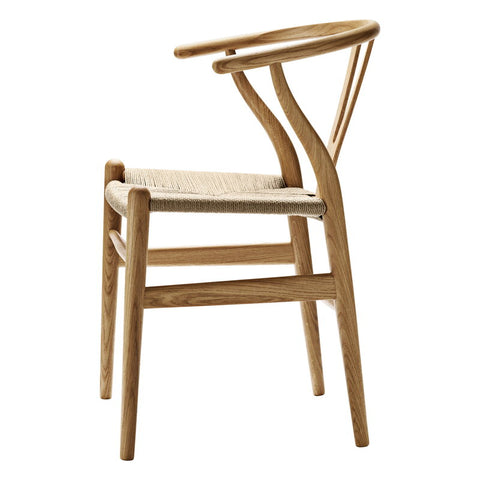Wishbone chair: A classic, unfashionable classic that triumphs in the home.
In the 60 years it has been on the market, this chair continues to captivate with its simplicity, naturalness, and comfort.
One of the most celebrated creations of Danish designer Hans J. Wegner is undoubtedly the Wishbone chair. Made for Carl Hansen & Son in 1949, it has been in continuous production from 1950 to today. This model, also known as CH24, is easily recognizable by its organic and attractive lines, which embrace you and the use of natural materials, and its characteristic Y-shaped backrest. A seat that represents the good workmanship of Nordic design, a beautiful object designed for usability. Today it is manufactured in different finishes, woods, and colors and has become a versatile piece essential for many when decorating the house.
Passionate about wood from the beginning. Hans J. Wegner was born in 1914 in Denmark and is one of the most influential figures in what later came to be known as Nordic or Scandinavian design. During his lifetime, the cabinetmaker, designer, and architect created more than 500 chairs, of which different companies mass-produced at least one hundred. Many of them, such as the wishbone, is still on the market and are design icons in museum collections worldwide.
First steps in craftsmanship. Wegner apprenticed himself to a cabinetmaker in his youth, and it was there that he discovered his passion for wood. He continued in the workshop until he was 20 years old and, after a period in the army, he studied design and later architecture. All the knowledge he learned during these years he oriented to his passion: woodworking craftsmanship.
More than 100 steps to create this classic. One of the keys to the success of this model is its natural look and simplicity, although it is the result of a process that is anything but simple. As one of John Maeda's principles of simplicity says: "Simplicity and complexity need each other."
It is a chair with a handcrafted development in which the 14 parts - the same as in the original 1949 design - are assembled in about 100 different steps. The complete assembly takes about three weeks. A short explanatory video is available on the Carl Hansen & Son website.
They are designed to last. The seat is made of paper cord, a cord made of natural fibers, braided and robust, which gives it excellent resistance. The life cycle of this material is approximately 50 years, but once it is damaged, it can be replaced, so the life of the chair is even longer. About 120 meters of this material is used, available in natural, white, or black.
Shapes borrowed from nature. Each of the manufacturing steps of the chair deepens the artisan essence of this object and help to give it that final aspect so refined and straightforward that it invites it to the touch. The legs are worked and sanded manually, marking the curvature of the legs, which gives the chair its distinctive shape. The Y-shaped piece of the backrest is the one that provides the chair with its name: Wishbone, which translates as "wishbone." It is the wishbone, a bone that birds have in this shape, and an object that brings good luck for the superstitious.
For every taste, there are colors. Currently, the chair is produced in six different wood varieties and various colors, a recent development. In addition, the seat can be chosen in natural, white, or black. The result is more than 150 different combinations that make this piece of furniture adaptable to all types of interiors. However, the most successful versions are still those with a more natural look.

Boby: The timeless trolley conceived by a design dandy
No one has ever overshadowed Joe Colombo: a visionary of industrial design whose story we tell you.
One of the most influential personalities in contemporary design, architect Joe Colombo (Milan, 1930-1971), died young but left behind many inventions and experiments, some of which are still relevant today. The Boby trolley is one of them. Joe Colombo designed it in 1970 using the new ABS plastic injection technologies, and it has multiple drawers that pivot on a fixed point to open and close, as well as trays and various compartments.
Colombo has been defined as a design swell, as he led a worldly life that included pipe smoking, a taste for racing cars, playing jazz, or competitive skiing. Understanding this kind of overwhelming personality partly explains the exuberance and risk-taking of his work.
Coming from a family related to technology and having started his career as a painter, he combined these two things in his activity as a designer, resulting in advanced ideas for the sixties and even utopian about our environment. Joe Colombo was fascinated by new technologies and materials, such as the ABS plastic he used in this cart and his chair or the fiberglass used in his chair. Universal the fiberglass used in the Elda armchair. Already in his time, he talked about how people could get to work at home or while traveling in the future.
In that spirit, he came up with designs for the future in multifunctional mobile units, such as the Mini-kitchen or the Cabriolet bed, designs where flexibility and adaptability to different environments and situations are paramount. But also TV sets on the ceiling or pivoting walls with built-in minibar. The Boby trolley was specially designed as a companion to the architect's drawing table. However, its flexibility soon revealed its ability to take on a variety of functions in both domestic and public spaces.
Joe Colombo's partner, Ignazia Favata, has kept Joe Colombo's design studio open since his untimely death at the age of 41. According to her instructions, changes and adaptations of his pieces are made. For example, he adds wheels or sizes and colors, as the original version was only in black, white, and red.


